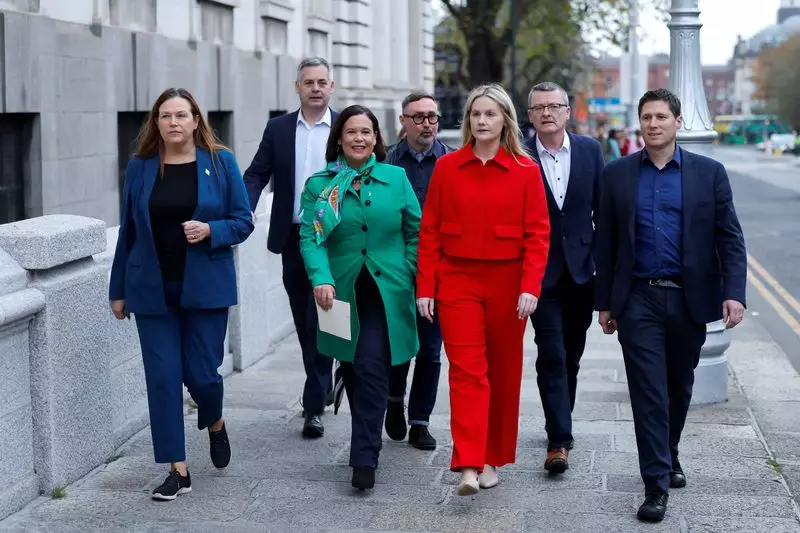As the landscape of Irish politics continues to evolve, Sinn Féin finds itself grappling with a striking decline in polling figures just ahead of a critical election. Once viewed as the potential frontrunner with the chance to lead a coalition government in Dublin, the party now seems to be relegated to the sidelines, raising questions about the future of Irish nationalism and the dream of a united Ireland. Political analysts have noted how this shift could significantly delay aspirations for reunification, which had once seemed within reach.
Earlier in the year, Sinn Féin was perched on the brink of significant political achievement, presenting an image of being not just relevant but transformative. It was poised to create a government that could unify efforts across both the Republic of Ireland and Northern Ireland, bolstering calls for a referendum on Irish unity. However, recent developments signal that the party’s electoral coalition is unraveling. This fragmentation primarily stems from discontent within traditional working-class voter segments, sparked by perceptions of Sinn Féin’s liberal stance on immigration—a touchstone issue for many in these communities.
The party’s ability to forge a broader coalition necessary for pursuing unity now appears precarious. With the November 29 election approaching, many are questioning whether Sinn Féin can overcome these newly emerging barriers, or if they will stall their ambitious plans for governance that includes initiatives like establishing an Irish minister for reunification.
On the ground, the sentiment around the push for Irish unity has shifted noticeably. During a recent campaign canvass in Donaghmede, an area known for strong support of Sinn Féin in the last electoral cycle, issues such as unaffordable housing and inadequate public services overwhelmingly dominated discussions with local residents. A prominent local teacher expressed that, although gathering on the topic of unity has occurred informally in the past, pressing economic concerns have overshadowed the discussion. For many voters, the immediate need for social and economic reform takes precedence over broader political objectives.
The stark reality is that while Sinn Féin champions the cause of Irish unification within its platform, this message does not resonate with many voters who are grappling with day-to-day challenges. This disconnect suggests that Sinn Féin must recalibrate its approach to include tangible solutions to pressing local issues while keeping the long-term vision of unity alive.
Interestingly, traditional rival parties, including Fine Gael and Fianna Fáil, have also relegated discussions of national unity, often treating it as a secondary theme. Fine Gael’s rather brief mention of Northern Ireland in their extensive election manifesto underscores a preference for a cautious and gradual approach to unity rather than a bold, immediatist one advocated by Sinn Féin. This caution is driven partly by the desire to manage resources effectively and ensure regional stability—a sentiment echoed by Fianna Fáil’s commitment to investing in cross-community infrastructure moves.
The current opinion polls indicate a potential consolidation of power amongst these traditional parties as they combine for up to 43% support, leaving Sinn Féin trailing at 18%. This shift represents a significant departure from a year ago, when the prospect of a Sinn Féin-led coalition seemed almost realistic. Their vision of governance now faces a daunting political climate in which they are increasingly seen as potential outsiders.
Amidst these challenges, Sinn Féin’s leadership remains hopeful, insisting that the ultimate poll being awaited is the one held on the Election Day itself. Party leader Mary Lou McDonald asserts that even if the immediate electoral outcome is unfavorable, the momentum toward reunification remains vital and will continue to be a focal point of Sinn Féin’s agenda. However, this ambition cannot navigate the complexities of Irish politics alone; a coalition of diverse political and civic entities will be essential to sustain the narrative around unity.
Although public sentiment in the Republic of Ireland largely supports the idea of a united Ireland, many observers stress that achieving this vision requires not only support from the electorate but also action from multiple political platforms. The 1998 Good Friday Agreement, which set forth guidelines for a potential referendum on unity, reflects a commitment that is contingent upon public opinion.
As the Irish electoral contest unfolds, the future trajectory of nationalist aspirations hangs in the balance. Sinn Féin’s struggles encapsulate a broader dialogue about identity, governance, and the pace of political change in Ireland. The dream of a united Ireland, while rooted in history and supported by a plurality of the populace, must navigate the realities of contemporary politics—where unity is not merely a political slogan, but rather, a multifaceted goal that invites collaboration beyond singular party lines. For now, the dream is held within the collective hopes of the Irish people, awaiting a clarion call for unity that transcends electoral numbers and resonates with the ambitions of a shared future.


Leave a Reply